I was asked recently by a communications agency in Sydney to answer some questions about the similarities and differences of Strategic and Creative Thinking as they began their annual planning for its clients. I’ve posted my general notes from those meetings below.
What does Creative Thinking have to do with Strategic Thinking?
In a word, everything. Creativity is essential to Strategy, and vice versa. Yin and Yang, as it were.
Strategic Thinking sets a clear linear path to accomplish a desired business goal, and typically is based on three essential items:
- Concise and measurable objectives linking to the business outcome,
- A clear perspective of the problems to be addressed (and potentially, to leverage opportunities), and
- A thorough understanding of the resources which should be leveraged to implement the strategic plan, such as budget, personnel, infrastructure and operations.
Strategic Thinking is Convergent Thinking, or distilling information, perspectives and knowledge to a distinct insight or a decision, often about a specific problem.
Creative Thinking is Divergent Thinking, or expanding or building upon insight(s) to create alternative solutions or possibilities (also known as ideas) to solve specific problems.
That said, one can be strategic without being creative, or be creative without being strategic. However, successful programs – and people – are always both. You can’t have a good strategic plan without an effective creative solution, and you can’t have a good creative solution without effective strategic thinking.
If the two processes were shapes, they’d look like the chart below. Notice how the shapes suggest what the brain should be doing: either narrowing down to an insight or decision, or expanding upon the insight to create many alternatives.
Two Side Notes:
There’s now a longer article outlining the differences between Strategic and Creative Thinking called .
There’s also an article specific to , both of which complement Strategic and Creative Thinking.
How Should You Approach Strategic Planning?
Regardless of their industry, all organisations can follow the same process to be both strategic and creative.
Articulate the specific goal that must be achieved, both from the perspective of the business and the communications roles.
Even the most basic communications tactic should have a direct link between its implementation and the goals of the business. If you don’t, how can you prove the tactic was successful? And, can you actually measure your goal(s)?
Identify and prioritise the issues or problems which are preventing the goals from being achieved.
As much as possible, make sure you’re solving a problem and not a symptom. Symptoms might seem urgent – such as ‘Falling share price‘ – but they’re typically short-term. Problems are long-term and require sustained attention, such as the ‘Falling share price is a direct result of a poor reputation of the company’s leadership.‘
Mapping out opportunities, assets or trends are also helpful, either to counter-act the problems or help create a more ideal future. But remember too that opportunities don’t stand in the way of being successful. An organisation needs to eliminate, minimise or contextualise its problems to be effective and successful.
Identify precisely the audience you need to understand in order to create a change in knowledge, opinion or behaviour.
End users of any type are best articulated through their demographics (facts, statistics) and psychographics (behaviours, attitudes). As the old marketing phrase goes, Facts persuade but emotion motivates.
Be as precise as possible. ‘Women’ isn’t a target audience, it’s a gender. “People who make the purchasing decision in the household’ is an audience.
Understand the current mindset of the audience you’re trying to address – and don’t judge what they think.
You cannot change another person’s mind unless you know and understand what they believe now, and why. Again, take time to understand both the rational reasons and emotional levers which convince the key audiences to re-evaluate their opinions or change their behaviour. Otherwise, messages tend to sound more like propaganda than compelling reasons to change one’s mindset.
Define exactly what you want the key audiences to do.
Any campaign tactic must directly reinforce to the audience the desired outcome. This outcome is rarely a 180˚ mindset shift from ‘I hate you‘ to ‘I love you.‘ Be realistic and transparent with what you want the audience to believe. Otherwise, your messages will sound self-serving.
Develop ideas which address all of the previous steps.
Clever ideas which are interesting but not engaging are a waste of resources, similar to an intelligent strategic plan without a cut-through idea. More so, you should also decide the criteria that you’ll use to select the best idea.
Anything you’re like to add? Feel free to add your comments below.



No comment yet, add your voice below!